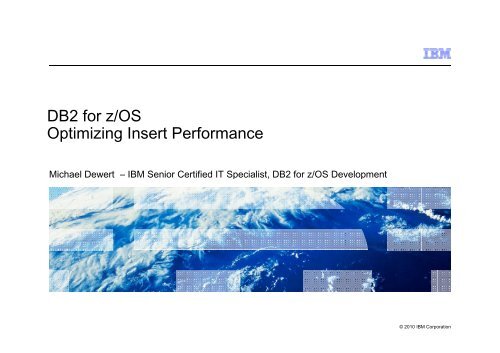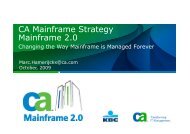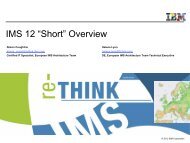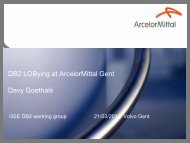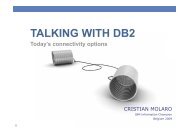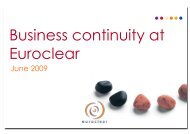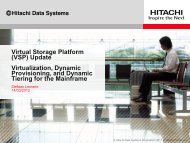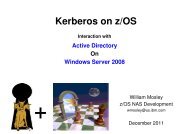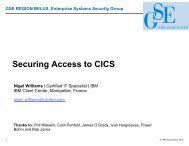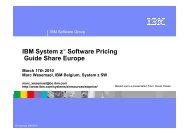Optimizing SQL Insert Performance - GSE Belux
Optimizing SQL Insert Performance - GSE Belux
Optimizing SQL Insert Performance - GSE Belux
Create successful ePaper yourself
Turn your PDF publications into a flip-book with our unique Google optimized e-Paper software.
DB2 for z/OS<br />
<strong>Optimizing</strong> <strong>Insert</strong> <strong>Performance</strong><br />
Michael Dewert<br />
– IBM Senior Certified IT Specialist, DB2 for z/OS Development<br />
© 2010 IBM Corporation
Objectives<br />
• Understand typical performance bottlenecks<br />
• How to design and optimise i for high h performance<br />
• How to tune for optimum performance<br />
• Understand d the new features of DB2 V9 and V10<br />
• Understand how to best apply and use new features<br />
2<br />
© 2010 IBM Corporation
Agenda<br />
• <strong>Insert</strong> Space Search<br />
• Most Important Tablespace Attributes<br />
• Typical <strong>Performance</strong> Bottlenecks and Tuning<br />
• DB2 9 and 10 <strong>Performance</strong> Enhancements<br />
• How to use the new features of DB2 9 and 10<br />
• Summary<br />
3<br />
© 2010 IBM Corporation
Key Physical Design Questions<br />
• Design for maximum performance throughput or space reuse?<br />
• Random key insert or sequential key insert?<br />
• Store rows in clustering sequence or insert at the end?<br />
• Input records sorted into clustering key sequence?<br />
• What are indexing requirements and are they justified?<br />
4<br />
© 2010 IBM Corporation
Choice: <strong>Performance</strong> or Space Reuse<br />
• High performance, than less space reuse<br />
• Better space reuse, than less performance<br />
• Classic partitioned tablespace<br />
– Usually better performance especially in data sharing environment<br />
• Segmented or Universal tablespace<br />
– Usually better space management due to more space information in spacemap pages<br />
5<br />
© 2010 IBM Corporation
Simple <strong>Insert</strong> Flow with clustering key<br />
INSERT<br />
Clustering<br />
Index<br />
Get IX pages<br />
Read I/O wait<br />
From index or<br />
data page<br />
CPU time<br />
Get page from<br />
space search<br />
Deferred Write<br />
I/O Wait<br />
Space map page<br />
Find data page<br />
Write logs<br />
Page<br />
Latch or<br />
P-lock<br />
wait<br />
Return AP<br />
Update pages<br />
© 2010 IBM Corporation
Space Search Steps (Classic Partitioned/UTS in V10)<br />
Search from free space to the end<br />
with physical extend<br />
4<br />
2<br />
Search<br />
adjacent<br />
2<br />
End<br />
Search the<br />
end with<br />
Extend<br />
1<br />
3<br />
Search the<br />
end<br />
Without<br />
physical<br />
extend<br />
5<br />
6<br />
Exhaustive search<br />
© 2010 IBM Corporation
Space search steps (Classic Segmented/UTS in V9)<br />
Search the space map page that contains lowest segment has<br />
free space to the end of space map page<br />
2<br />
Search<br />
adjacent<br />
pages<br />
within the<br />
segment<br />
2<br />
3<br />
End<br />
4<br />
Search the<br />
end<br />
Without<br />
physical<br />
extend<br />
Search the<br />
end with<br />
Extend<br />
1<br />
5<br />
Search from lowest segment<br />
that has free space<br />
5<br />
Extend<br />
failed<br />
6<br />
Exhaustive search from the beginning of table space<br />
© 2010 IBM Corporation
PBG search algorithm for entire table space<br />
Part 1 Part 2 part 3 part 4<br />
Thread 1 Thread 2 Thread 3<br />
Thread 4<br />
T1 T2<br />
T3<br />
T4<br />
<strong>Insert</strong><br />
to<br />
Part 3<br />
<strong>Insert</strong><br />
to<br />
Part 3<br />
<strong>Insert</strong><br />
to<br />
Part 2<br />
<strong>Insert</strong><br />
to<br />
Part 3<br />
© 2010 IBM Corporation
Most Important Tablespace Attributes<br />
10<br />
© 2010 IBM Corporation
Segmented Tablespace<br />
• Segmented tablespace provides for more efficient search in fixed length<br />
compressed and true variable length row insert<br />
– Spacemap page contains more information on available space so that only a data page<br />
with guaranteed available space is accessed<br />
• 2 bits per data page in non segmented tablespace (2**2=4 different conditions)<br />
• 4 bits per data page in segmented tablespace (2**4=16 different conditions)<br />
– But more spacemap page updates<br />
• Possible performance penalty with data sharing<br />
11<br />
© 2010 IBM Corporation
Segmented Tablespace …<br />
• SEGSIZE<br />
– General recommendation is to use large SEGSIZE value consistent t with size of pageset<br />
• Typical SEGSIZE value 32 or 64<br />
– Large SEGSIZE<br />
• Provides better opportunity to find space in page near by to candidate page and<br />
therefore maintain clustering<br />
• Better chance to avoid exhaustive space search<br />
– Small SEGSIZE<br />
• Can reduce spacemap p page contention<br />
• But less chance of hitting ‘False Lead Threshold’ and looking for space at the end of<br />
pageset/partition<br />
‘False Lead’ is when spacemap page indicates there is a data page with room for the row,<br />
but on visit to the respective data page this is not the case<br />
• Also applies to Universal Table Space (DB2 9)<br />
12<br />
© 2010 IBM Corporation
Partitioned Tablespace<br />
• Use page range partitioning by dividing tablespace into partitions by key range<br />
• Spread insert workload across partitions<br />
i<br />
• Can reduce logical and physical contention to improve concurrency and reduce<br />
cost<br />
• Separate index B-tree for each index partition of partitioned index (good for<br />
concurrency)<br />
• Only one index B-tree for non-partitioned index (bad for concurrency)<br />
• Over wide partitioning has potential to reduce number of index levels to reduce<br />
performance cost<br />
13<br />
© 2010 IBM Corporation
Trade-off in Free Space Search<br />
• <strong>Insert</strong> to the end of pageset/partition<br />
– To minimize i i the cost of insert by minimising<br />
i i i<br />
• Read/Write I/Os, Getpages, Lock requests<br />
• Search for available space near the optimal page<br />
– To store data rows in clustering index sequence<br />
– To store leaf pages in index key sequence<br />
– To minimize dataset size<br />
• Search for available space anywhere within the allocated area<br />
– To minimise dataset size<br />
– Can involve exhaustive space search which is expensive<br />
– Use large PRIQTY/SECQTY and large SEGSIZE to minimize exhaustive space search<br />
14<br />
© 2010 IBM Corporation
Distributed Free Space<br />
• Use distributed free space – PCTFREE and/or FREEPAGE<br />
– For efficient i sequential read of index<br />
– For efficient sequential read of data via clustering index<br />
– To minimize index split<br />
• Carefully calculate settings<br />
• Default distributed free space<br />
– 0 FREEPAGE<br />
– 5% PCTFREE within data page<br />
– 10% PCTFREE within index page<br />
15<br />
© 2010 IBM Corporation
Distributed Free Space …<br />
• For best insert performance<br />
– Random key insert to index<br />
• Use non-zero index PCTFREE and/or FREEPAGE<br />
To reduce index leaf page splits<br />
For efficient sequential index read<br />
– Sequential key insert to index<br />
• Immediately after LOAD, REORG, or CREATE/RECOVER/REBUILD INDEX<br />
Use PCTFREE 0 to reduce the number of index pages and possibly index levels by<br />
populating each leaf page 100%<br />
– Use PCTFREE=FREEPAGE=0 for data to reduce both sync read and async write I/Os<br />
for each row insert<br />
• Possible performance penalty for query in terms of sync single page I/O when<br />
reading multiple rows via clustering index<br />
16<br />
© 2010 IBM Corporation
TRACKMOD NO<br />
• Reduces spacemap contention in data sharing environment<br />
• DB2 does not track changed pages in the spacemap pages<br />
• It uses the LRSN value in each page to determine whether a page has been<br />
changed since last copy<br />
• Trade-off as degraded performance for incremental image copy because of<br />
tablespace scan<br />
17<br />
© 2010 IBM Corporation
MEMBER CLUSTER<br />
• INSERT into “hot spots”<br />
– Resulting in excessive page p-lock and page latch contention ti on<br />
• Spacemap page<br />
• Data page if LOCKSIZE(ROW)<br />
– Can occur when<br />
• Concurrent insert in same area of the tablespace among different members in a data<br />
sharing environment<br />
• Tablespace has row level locking attribute<br />
• True sequential key or spot sequential key<br />
• MEMBER CLUSTER<br />
– Member-private spacemap and corresponding data pages<br />
18<br />
© 2010 IBM Corporation
MEMBER CLUSTER …<br />
• Rows inserted by <strong>Insert</strong> <strong>SQL</strong> are not clustered by clustering index<br />
– Instead, rows stored in available space in member-private area<br />
• Option not available on segmented tablespace or UTS<br />
19<br />
© 2010 IBM Corporation
MEMBER CLUSTER<br />
• Can reduce spacemap contention<br />
– Used in the high h concurrent insert in the data sharing environment<br />
– Can reduce spacemap sharing between data sharing members<br />
– In non-data sharing environment, smaller spacemap p page can reduce the interest of<br />
spacemap page between threads<br />
• Data clustering can be restored via REORG<br />
• Assuming insert-only workload, may want to use LOCKSIZE ROW and larger data<br />
page size when using MEMBER CLUSTER<br />
– Better space use<br />
– Reduce working set of bufferpool pages<br />
– Reduce # Getpages<br />
– Reduce # Lock Requests<br />
– Reduce # CF requests<br />
20<br />
© 2010 IBM Corporation
MEMBER CLUSTER, PCTFREE = 0 and FREEPAGE = 0<br />
• Introduced in V7 APAR PQ87381<br />
• Re-instated in V9 via APAR PK81470<br />
• Only applies to classic partitioned tablespace / simple tablespace<br />
• <strong>Insert</strong> to the end of tablespace without t looking at the free space<br />
• Will reduce longer chain of spacemap page search as tablespace gets bigger<br />
• Good for tablespace with seldom delete or update that creates free space<br />
• Exhaustive search through spacemap pages belong to the member before<br />
physical extend<br />
– Success depends on deletes and inserts being spread across members<br />
21<br />
© 2010 IBM Corporation
MAXROWS n<br />
• Optimisation to avoid wasteful space search on partitioned tablespace in fixed<br />
length compressed and true variable length row insert<br />
• Must carefully estimate ‘average’ row size and how many ‘average’ size rows will<br />
fit comfortably in a single data page<br />
• When MAXROWS n is reached the page is marked full and out of space search<br />
• But introduces on going maintenance challenges<br />
– Could waste space?<br />
– What happens if compression is removed?<br />
– What happens if switch from uncompressed to compressed?<br />
– What happens when new columns are added?<br />
22<br />
© 2010 IBM Corporation
Typical <strong>Performance</strong> Bottlenecks<br />
and Tuning Observations<br />
23<br />
© 2010 IBM Corporation
Read and Write I/O for Index and Data<br />
• Random key insert to index<br />
– N sync read I/Os for each index<br />
• N depends on # index levels, # leaf pages, and buffer pool availability<br />
• Index read I/O time = N * #indexes * ~1-2 ms<br />
– Sync data read I/O time = ~1-2 ms per page (0 if insert to the end)<br />
– Deferred async write I/O for each page<br />
• ~1-2 ms for each row inserted<br />
• Depends on channel type, device type, I/O path utilisation, and distance between<br />
pages<br />
– Recommend keeping the number of indexes to a minimum<br />
• Challenge the need for low value indexes<br />
24<br />
© 2010 IBM Corporation
Read and Write I/O for Index and Data …<br />
• Sequential insert to the end of data set<br />
– For data row insert, and/or ever-ascending or descending di index key insert<br />
– Can eliminate sync read I/O<br />
– Deferred async write I/O only for contiguous pages<br />
• ~0.4 ms per page filled with inserted rows<br />
• Time depends on channel type, device type and I/O path utilisation<br />
25<br />
© 2010 IBM Corporation
Read and Write I/O for Index and Data …<br />
• Recommendations on deferred write thresholds<br />
– VDWQT = Vertical (dataset t level) l) Deferred Write Thresholdh • Default: when 5% of buffers updated from one dataset, a deferred write is scheduled<br />
– DWQT = buffer pool level Deferred Write Threshold<br />
• Default: when 30% of buffers updated, a deferred write is scheduled<br />
– Want to configure for continuous ‘trickle’ write activity in between successive system<br />
checkpoints<br />
• VDWQT and DWQT will typically have to be set lower for very intensive insert<br />
workloads<br />
26<br />
© 2010 IBM Corporation
Read and Write I/O for Index and Data …<br />
• With high deferred write thresholds, write I/Os for data or index entirely resident in<br />
buffer pool can be eliminated except at system checkpoint or STOP<br />
TABLESPACE/DATABASE time<br />
• Use VDWQT=0% for data buffer pool with low hit ratio (1-5%) if single thread<br />
insert<br />
– Else VDWQT=150 + # concurrent threads (e.g., 100) if sequential insert to the end of<br />
pageset/partition<br />
– When 250 buffers are updated for this dataset, 128 LRU buffers are scheduled for write<br />
• Use VDWQT=0% for sequential index insert<br />
• Use default if not sure, also for random index insert<br />
27<br />
© 2010 IBM Corporation
Active Log Write<br />
• Log data volume<br />
– From DB2 log statistics, ti ti minimum i MB/sec of writing to active log dataset t can be<br />
calculated as<br />
#CIs created in Active Log * 0.004MB004MB<br />
----------------------------------------------------<br />
statistics interval in seconds<br />
– Pay attention to log data volume if >10MB/sec<br />
• Consider use of DB2 data compression<br />
• Use faster device as needed<br />
• Consider use of DFSMS striping<br />
28<br />
© 2010 IBM Corporation
Lock/Latch and Service Task Waits<br />
• Rule-of-Thumb on LOCKSIZE<br />
– Page lock (LOCKSIZE PAGE|ANY) as design default and especially if sequentially<br />
inserting many rows/page<br />
• Page P-lock contention in data sharing environment<br />
– Index page update<br />
– Spacemap page update<br />
– Data page update when LOCKSIZE ROW<br />
29<br />
© 2010 IBM Corporation
Lock/Latch and Service Task Waits …<br />
• Service task waits most likely for preformatting<br />
– Shows up in Dataset t Extend Wait in Accounting Class 3 Trace<br />
– Typically up to 1 second each time, but depends on allocation unit/size and device type<br />
– Anticipatory and asynchronous preformat in DB2 V7 significantly reduces wait time for<br />
preformat<br />
– Can be eliminated by LOAD/REORG with PREFORMAT option and high PRIQTY value<br />
– Do not use PREFORMAT on MEMBER CLUSTER tablespace with high h PRIQTY<br />
30<br />
© 2010 IBM Corporation
DB2 Latch Contention<br />
• Latch Counters LC01-32 in OMPE Statistics Report Layout Long<br />
• Rule-of-Thumb on Internal DB2 latch contention ti rate<br />
– Investigate if > 10000/sec<br />
– Ignore if < 1000/sec<br />
• Class 6 for latch for index tree P-lock due to index split - Data sharing only<br />
– Index split is painful in data sharing - results in 2 forced physical log writes<br />
– Index split time can be significantly reduced by using faster active log device<br />
– Index splits in random insert can be reduced by providing non-zero PCTFREE<br />
• Class 19 for logical log write latch - Both non-data sharing and data sharing<br />
– Use LOAD LOG NO instead of <strong>SQL</strong> INSERT<br />
– Make sure Log Output Buffer fully backed up by real storage<br />
– Eliminate Unavailable Output Log Buffer condition<br />
• If >1K-10K contentions/sec, disabling Accounting Class 3 trace helps to<br />
significantly reduced CPU time as well as elapsed time<br />
31<br />
© 2010 IBM Corporation
Identity Column and Sequence Object<br />
• DB2 to automatically generate a guaranteed-unique number for sequencing each<br />
row inserted into table<br />
• Much better concurrency, throughput, and response time possible<br />
– Compared to application maintaining a sequence number in one row table, which forces<br />
a serialisation (one transaction at a time) from update to commit<br />
– Potential for 5 to 10 times higher insert/commit rate<br />
• Option to cache (default of 20), saving DB2 Catalog update of maximum number<br />
for each insert<br />
– Eliminating GBP write and log write force for each insert in data sharing<br />
• Recycling or wrapping of identity column and sequence value<br />
32<br />
© 2010 IBM Corporation
GENERATE_UNIQUE()<br />
• Built-in function with no arguments<br />
• Returns a bit data character string 13 bytes long<br />
• Provides a unique value which is not sequential<br />
– Unique compared to any other execution of the same function<br />
• Allocation does not involve any CF access<br />
• Based exclusively on STCK value<br />
• DB2 member number and CPU number are embedded for uniqueness<br />
• Example<br />
CREATE TABLE EMP_UPDATE<br />
(UNIQUE_ID CHAR(13) FOR BIT DATA,<br />
EMPNO CHAR(6),<br />
TEXT VARCHAR(1000)) ;<br />
INSERT INTO EMP_UPDATE VALUES (GENERATE_UNIQUE(), ’000020’, ’Update entry...’) ;<br />
33<br />
© 2010 IBM Corporation
Multi Row <strong>Insert</strong> (MRI)<br />
• INSERT INTO TABLE for N Rows Values (:hva1,:hva2,…)<br />
• Up to 40% CPU time reduction by avoiding <strong>SQL</strong> API overhead for each INSERT<br />
call<br />
– % improvement lower if more indexes, more columns, and/or fewer rows inserted per<br />
call<br />
• ATOMIC (default) is better from performance viewpoint as create of multiple<br />
SAVEPOINT log records can be avoided<br />
• Dramatic reduction in network traffic and response time possible in distributed<br />
environment<br />
– By avoiding message send/receive for each row<br />
– Up to 8 times faster response time and 4 times CPU time reduction<br />
34<br />
© 2010 IBM Corporation
DB2 9 <strong>Performance</strong> Enhancements<br />
35<br />
© 2010 IBM Corporation
Reduced LRSN Spin and Log Latch Contention<br />
• Delivered in CM->NFM and automatic<br />
• For data sharing<br />
• Less DB2 spin for TOD clock to generate unique LRSN for log stream for a given<br />
DB2 member<br />
– Unique LRSN only required as it pertains to a single index or data page<br />
• No longer holds on to log output buffer latch (LC19) while spinning<br />
• Potential to reduce LC19 Log latch contention<br />
• Potential to reduce CPU time especially when running on faster processor<br />
36<br />
© 2010 IBM Corporation
Large Index Page Size<br />
• Available in NFM<br />
• With or without index compression<br />
• Potential to reduce the number of index leaf page splits, which are painful<br />
especially for GBP-dependent index (data sharing)<br />
– Reduce index tree latch contention<br />
– Reduce index tree p-lock contention<br />
• Potential to reduce the number of index levels<br />
– Reduce the number of getpages for index traversal<br />
– Reduce CPU resource consumption<br />
• Possibility that large index page size may aggravate index buffer pool hit ratio for<br />
random access<br />
37<br />
© 2010 IBM Corporation
Large Index Page Size Examples<br />
Rows In Table 1,000,000,000<br />
Key Length 4 8 16 32 64 128 256 512 1024<br />
Page Size<br />
4096<br />
Entries/Leaf 336 252 168 100 56 29 15 7 3<br />
Leafs 2,976,191 3968254 3,968,254 5952381 5,952,381 10,000,000000 000 17,857,143 143 34,482,759482 66,666,667666 667 142,857,143 143 333,333,334<br />
334<br />
Non-Leaf fanout 331 242 158 93 51 26 13 7 3<br />
Index Levels 4 4 5 5 6 7 9 11 19<br />
8192<br />
Entries/Leaf 677 508 338 203 112 59 30 15 7<br />
Leafs 1,477,105 1,968,504 2,958,580 4,926,109 8,928,572 16,949,153 33,333,334 66,666,667 142,857,143<br />
Non-Leaf fanout 666 488 318 187 103 54 27 14 7<br />
Index Levels 4 4 4 4 5 6 7 8 11<br />
16,384<br />
Entries/Leaf 1360 1020 680 408 226 120 61 31 15<br />
Leafs 735,295 980,393 1,470,589 2,450,981 4,424,779 8,333,334 16,393,443 32,258,065 66,666,667<br />
Non-Leaf fanout 1,336 980 639 376 207 108 55 28 14<br />
Index Levels 3 4 4 4 4 5 6 7 8<br />
32,768<br />
Entries/Leaf 2725 2044 1362 817 454 240 123 62 31<br />
Leafs 366,973 489,237 734,215 1,223,991 2,202,644 4,166,667 8,130,082 16,129,033 32,258,065<br />
Non-Leaf fanout 2,676 1,963 1,280 755 414 218 111 56 28<br />
Index Levels 3 3 3 4 4 4 5 6 7<br />
38<br />
© 2010 IBM Corporation
Increased Index Look Aside<br />
• Prior to DB2 9, for clustering index only<br />
• In DB2 9, now possible for additional i indexes where CLUSTERRATIO >= 80%<br />
• Potential for big reduction in the number of index getpages with substantial<br />
reduction in CPU time<br />
39<br />
© 2010 IBM Corporation
Asymmetric Leaf Page Split<br />
• Available in NFM and automatic<br />
• Design point is to provide performance relief for classic sequential index key problem<br />
• Asymmetric index page split will occur depending on an insert pattern when inserting in<br />
the middle of key range<br />
– Instead of previous 50-50 split prior to DB2 9<br />
– Up to 50% reduction in index split<br />
• Asymmetric split information is tracked in the actual pages that t are inserted into, so it<br />
is effective across multiple threads across DB2 members<br />
• PK62214 introduces changes to the tracking and detection logic, and it should work<br />
much better for data sharing<br />
– Before: DB2 9 only remembered the last insert position and a counter<br />
– Now: DB2 remembers an insert 'range‘ and tolerates entries being slightly out of order<br />
• It may still not be effective for large key sizes (hundreds of bytes), or if entries come in very bad order<br />
(i.e., they do not look sequential)<br />
• But for simple cases like 3, 2, 1, 6, 5, 4, 9, 8, 7, 12, 11, 10 ... DB2 will be able to determine that the<br />
inserted entries are ascending<br />
40<br />
© 2010 IBM Corporation
Randomised Index Key<br />
• Index contention can be a major problem and a limit for scalability<br />
• This problem is more severe in data sharing because of index page P-<br />
lock contention<br />
• A randomized d index key can reduce lock contention<br />
ti<br />
• CREATE/ALTER INDEX … column-name RANDOM,<br />
instead of ASC or DESC<br />
• Careful trade-off required between lock contention relief and additional<br />
getpages, g read/write I/Os, and increased number of lock requests<br />
• This type of index can provide dramatic improvement or degradation!<br />
– e.g. Very bad choice for applications with range predicates<br />
• Recommend making randomized indexes only when buffer pool resident<br />
41<br />
© 2010 IBM Corporation
Identifying Unreferenced Indexes<br />
• Additional indexes require overhead for<br />
– Data maintenance<br />
• INSERT, UPDATE, DELETE<br />
– Utilities<br />
• REORG, RUNSTATS, LOAD etc<br />
– DASD storage<br />
– Query optimization time<br />
• Increases DB2 Optimizer’s choices to consider<br />
• But identifying i unused indexes is a difficult task<br />
– Especially in a dynamic <strong>SQL</strong> environment<br />
42<br />
© 2010 IBM Corporation
Identifying Unreferenced Indexes …<br />
• RTS records the index last used date<br />
– SYSINDEXSPACESTATS.LASTUSED<br />
• Updated once in a 24 hour period<br />
RTS service task updates at first externalization interval (set by STATSINT) after 12PM<br />
• If the index is used by DB2, update occurs<br />
• If the index was not used, no update<br />
• “Used” as defined by DB2 means<br />
– As an access path for query or fetch<br />
– For searched UPDATE / DELETE <strong>SQL</strong> statement<br />
t t<br />
– As a primary index for referential integrity<br />
– To support foreign key access<br />
43<br />
© 2010 IBM Corporation
Table APPEND Option<br />
• New APPEND option is provided for INSERT<br />
– CREATE/ALTER TABLE … APPEND YES<br />
• Always use with MEMBER CLUSTER in data sharing<br />
• Will reduce longer chain of spacemap page search as tablespace keeps getting<br />
bigger<br />
• But will drive need for more frequent tablespace reorganization<br />
• Degraded query performance until the reorganization is performed<br />
• Behaviour the same as ‘pseudo append’ with “MC00”<br />
– MEMBER CLUSTER and PCTFREE=FREEPAGE=0<br />
– Will switch between append and insert mode<br />
– Success depends d on deletes and inserts being spread across DB2 members of data<br />
sharing group<br />
44<br />
© 2010 IBM Corporation
DB2 10 <strong>Performance</strong> Enhancements<br />
45<br />
© 2010 IBM Corporation
V10 Enhancements<br />
• Index I/O parallelism for non-segmented tablespace<br />
• Unique Index with INCLUDE columns<br />
• Log latch contention relief<br />
• Faster log I/O during commit<br />
• Index look aside for referential integrity<br />
• In-line LOB<br />
• Space search improvement for UTS<br />
• Support MEMBER CLUSTER for UTS<br />
• Additional LRSN spin avoidance<br />
• Page fix of output log buffer<br />
46<br />
© 2010 IBM Corporation
V10 Enhancements ...<br />
• In-line LOB<br />
• Space search improvement for UTS<br />
• Support MEMBER CLUSTER for UTS<br />
• Additional LRSN spin avoidance<br />
• Page fix of output log buffer<br />
47<br />
© 2010 IBM Corporation
Summary<br />
48<br />
© 2010 IBM Corporation
Summary – Key Points<br />
• Decide whether the data rows should be clustered/appended at the end<br />
• Sort inserts into clustering key sequence<br />
• Use classic partitioned tablespace and partitioned indexes<br />
• Keep the number of indexes to a minimum and drop low value indexes<br />
• Tune deferred write thresholds and distributed free space to drive ‘trickle write’<br />
• Use large PRIQTY/SECQTY and large SEGSIZE to reduce frequency of<br />
exhaustive space search<br />
• Use data compression to minimise log record size<br />
• Use faster channel, faster device, DFSMS striping for active log write throughput<br />
• Use MEMBER CLUSTER and TRACKMOD NO to reduce spacemap page<br />
contention and when using LOCKSIZE ROW to reduce data page contention<br />
• Use Identity column, sequence object, GENERATE_UNIQUE() built-in function<br />
with caching to efficiently generate a unique key<br />
• Important new DB2 9 new feature functions such as large index page size<br />
49<br />
© 2010 IBM Corporation
Michael Dewert – IBM Senior Certified IT Specialist, DB2 for z/OS Development<br />
dewert@de,ibm.com<br />
© 2010 IBM Corporation


